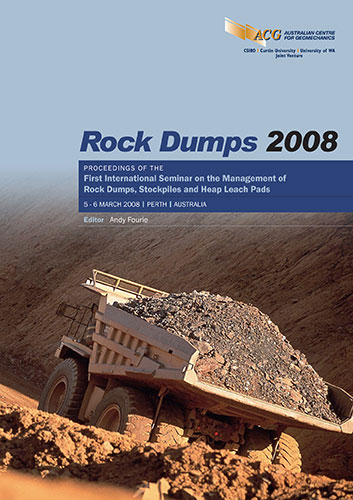The Use of Geosynthetics in Mining Works

|
Authors: Pries, J; Bishop, D; Hayes, S Paper is not available for download Contact Us |
DOI https://doi.org/10.36487/ACG_repo/802_5
Cite As:
Pries, J, Bishop, D & Hayes, S 2008, 'The Use of Geosynthetics in Mining Works', in AB Fourie (ed.), Rock Dumps 2008: Proceedings of the First International Seminar on the Management of Rock Dumps, Stockpiles and Heap Leach Pads, Australian Centre for Geomechanics, Perth, pp. 57-64, https://doi.org/10.36487/ACG_repo/802_5
Abstract:
Heap leach facilities are some of the largest man-made fill structures in the world. The design and construction of heap leach facilities have to follow the existing regulations to protect the environment against the very harsh and hazardous conditions. A very important but also critical component in the design, construction and operation of heap leach facilities is the liner system. It has to be designed to guarantee a sufficient quality, in consideration of the long-term responsibility for the environment, as well as in consideration of enhancing solution recovery and therewith operational benefit. Due to the long-term requirements of environmental protection, the surrounding climate and weather conditions in the area of a heap leach facility can lead to the requirement of a capping sealing system upon completion of the mining activities. This paper presents a summary of common heap leach pad designs using geosynthetic components. It shows the design and operation-related requirements for the single components of a heap leach pad lining system (low permeability soil, geomembrane, mineral drainage layer) and the interaction of the layers by project- specific boundary conditions. This paper does not include any design requirements or recommendations for the solution collection piping and the air injecting piping. The authors do not want to introduce themselves as mine experts, but with a large experience in landfill lining systems and geosynthetics.
References:
ASTM D5896 ASTM International, Standard Test Method for Microscopic Evaluation of the Dispersion of Carbon
Black in Polyolefin Geosynthetics
ASTM D5890 ASTM International, Standard Test Method for Swell Index of Clay Mineral Component of Geosynthetic
Clay Liners (04.09)
Bonaparte, R., Giroud, J.P. and Gross, B. (1989) Rates of leakage through landfill liners, Proceedings of Geosynthetics
'89,Vol I. San Diego California.
Bonaparte, R. and Gross, B. (1990) Field behaviour of double-liner systems, Proceedings of Symposium/GT Div.
ASCE National Convention, San Francisco, California.
Breitenbach, A.J. (1999) The Good, the Bad and the Ugly Lessons Learned in the Design and Construction of Heap
Leach Pads, SME Annual Meeting Presentation, Denver, Colorado, SME 99-186, pp. 1 to 15.
Breitenbach, A.J. and Thiel, R.S. (2005) A Tale of two conditions: Heap Leach Pad versus Landfill liner strength.
Defilippis, M.O. (2005) Geomembranes used in heap leach SX-EW Mining: A Manufacturer's Perspective, SL
Limitada, Snatiago and Antofagasta, Chile.
DGGT (2007) GDA-Empfehlungen - Geotechnik der Deponien und Altlasten; Ernst und Sohn; 3. Auflage 2007.
Giroud, J.P. and Bonaparte, R. (1989a) Leakage through liners constructed with geomembranes – Part I Geomembrane
Liners, Geotextiles and Geomembranes 8.
Giroud, J.P. and Bonaparte, R. (1989b) Leakage through liners constructed with geomembranes – Part II Geomembrane
Liners, Geotextiles and Geomembranes 8.
Geotechnical Issues – Strength, Stability and Seepage
Rock Dumps 2008, Perth, Australia 63
Giroud, J.P., Badu-Tweneboah, K. and Bonaparte, R. (1992) Rate of leakage through a composite liner due to
geomembrane defects, Geotextiles and Geomembranes 11.
Giroud, J.P., Badu-Tweneboah, K. and Soderman, K.L. (1995) Theoretical analysis of geomembrane puncture,
Geosynthetics Internal, Vol. 2, No. 6, pp. 1019-1048.
Lupo, J.F., Harmon, J. and Morrison, K. (2003) Solution Collection Design Issues on Large Heap Facilities, Tailings
and Mine Waste Conference 03, Vail, Colorado, USA.
Lupo, J.F. and Morrison, K. (2005) Innovative Geosynthetic Liner Design Approaches and Construction in the Mining
Industry, GeoFrontiers 2005, ASCE, Austin, Texas, USA.
Lupo, J.F. (2005) Heap Leach Facility Liner Design. Golder Associates Inc., Lakewood, Colorado, USA.
NAUE GmbH & Co. KG (1995) Results of internal testing, not publicised (Germany).
Thiel, R. and Smith, M.E. (2003) State of the practice review of heap leach pad design issues, Vector Engineering, Inc.
Grass Valley, CA, USA.
Seeger, S. (1995) Anforderungen an die Schutzschicht für die Dichtungsbahnen in der Kombinationsdichtung, Teil 1:
Wirksamkeit (lastverteilende Wirkung und Beständigkeit), Material und Prüfverfahren bei Schutzschichten, 8/95
Müll und Abfall, Germany.
Wikipedia; Internet Website: en.wikipedia.org/wiki/Heap_leaching.
The Use of Geosynthetics in Mining Works J. Pries, et al.
64 Rock Dumps 2008, Perth, Australia
© Copyright 2026, Australian Centre for Geomechanics (ACG), The University of Western Australia. All rights reserved.
View copyright/legal information
Please direct any queries or error reports to repository-acg@uwa.edu.au
View copyright/legal information
Please direct any queries or error reports to repository-acg@uwa.edu.au